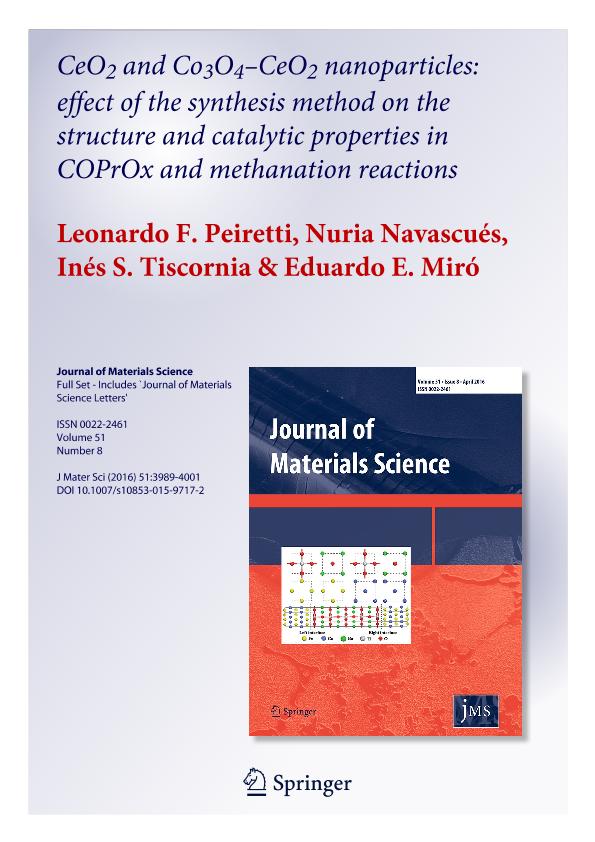Mostrar el registro sencillo del ítem
dc.contributor.author
Peiretti, Leonardo Federico

dc.contributor.author
Navascués, Nuria
dc.contributor.author
Tiscornia, Ines Silvia

dc.contributor.author
Miro, Eduardo Ernesto

dc.date.available
2018-02-16T20:23:24Z
dc.date.issued
2016-04
dc.identifier.citation
Peiretti, Leonardo Federico; Navascués, Nuria; Tiscornia, Ines Silvia; Miro, Eduardo Ernesto; CeO2 and Co3O4-CeO2 nanoparticles: effect of the synthesis method on the structure and catalytic properties in COPrOx and methanation reactions; Springer; Journal of Materials Science; 51; 8; 4-2016; 3989-4001
dc.identifier.issn
0022-2461
dc.identifier.uri
http://hdl.handle.net/11336/36671
dc.description.abstract
CeO2 and Co3O4–CeO2 nanoparticles were synthesized, thoroughly characterized, and evaluated in the COPrOx reaction. The CeO2 nanoparticles were synthesized by the diffusion-controlled precipitation method with ethylene glycol. A notably higher yield was obtained when H2O2 was used in the synthesis procedure. For comparison, two commercial samples of CeO2 nanoparticles (Nyacol®)—one calcined and the other sintered—were also studied. Catalytic results of bare CeO2 calcined at 500 °C showed a strong influence of the method of synthesis. Despite having similar BET area values, the CeO2 synthesized without H2O2 was the most active sample. Co3O4–CeO2 catalysts with three different Co/(Co + Ce) atomic ratios, 0.1, 0.3, and 0.5, were prepared by the wet impregnation of the CeO2 nanoparticles. TEM and STEM observations showed that impregnation produced mixed oxides composed of small CeO2 nanoparticles located both over the surface and inside the Co3O4 crystals. The mixed oxide catalysts prepared with a cobalt atomic ratio of 0.5 showed methane formation, which started at 200 °C due to the reaction between CO2 and H2. However, above 250 °C, the reaction between CO and H2 became important, thus contributing to CO elimination with a small H2 loss. As a result, CO could be totally eliminated in a wide temperature range, from 200 to 400 °C. The methanation reaction was favored by the reduction of the cobalt oxide, as suggested by the TPR experiments. This result is probably originated in Ce–Co interactions, related to the method of synthesis and the surface area of the mixed oxides obtained.
dc.format
application/pdf
dc.language.iso
eng
dc.publisher
Springer

dc.rights
info:eu-repo/semantics/openAccess
dc.rights.uri
https://creativecommons.org/licenses/by-nc-sa/2.5/ar/
dc.subject
Temperature Program Reduction
dc.subject
Methanation Reaction
dc.subject
Temperature Program Reduction Profile
dc.subject
Co3o4
dc.subject
Ceo2
dc.subject.classification
Otras Ingeniería Química

dc.subject.classification
Ingeniería Química

dc.subject.classification
INGENIERÍAS Y TECNOLOGÍAS

dc.title
CeO2 and Co3O4-CeO2 nanoparticles: effect of the synthesis method on the structure and catalytic properties in COPrOx and methanation reactions
dc.type
info:eu-repo/semantics/article
dc.type
info:ar-repo/semantics/artículo
dc.type
info:eu-repo/semantics/publishedVersion
dc.date.updated
2018-01-18T17:20:33Z
dc.journal.volume
51
dc.journal.number
8
dc.journal.pagination
3989-4001
dc.journal.pais
Alemania

dc.journal.ciudad
Berlin
dc.description.fil
Fil: Peiretti, Leonardo Federico. Consejo Nacional de Investigaciones Científicas y Técnicas. Centro Científico Tecnológico Conicet - Santa Fe. Instituto de Investigaciones en Catálisis y Petroquímica ; Argentina
dc.description.fil
Fil: Navascués, Nuria. Universidad de Zaragoza. Instituto de Nanociencia de Aragón; España
dc.description.fil
Fil: Tiscornia, Ines Silvia. Consejo Nacional de Investigaciones Científicas y Técnicas. Centro Científico Tecnológico Conicet - Santa Fe. Instituto de Investigaciones en Catálisis y Petroquímica ; Argentina
dc.description.fil
Fil: Miro, Eduardo Ernesto. Consejo Nacional de Investigaciones Científicas y Técnicas. Centro Científico Tecnológico Conicet - Santa Fe. Instituto de Investigaciones en Catálisis y Petroquímica ; Argentina
dc.journal.title
Journal of Materials Science

dc.relation.alternativeid
info:eu-repo/semantics/altIdentifier/url/http://link.springer.com/article/10.1007/s10853-015-9717-2
dc.relation.alternativeid
info:eu-repo/semantics/altIdentifier/doi/https://doi.org/10.1007/s10853-015-9717-2
Archivos asociados
